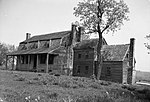Danville, Prince George's County, Maryland
Prince George's County, Maryland geography stubsUnincorporated communities in MarylandUnincorporated communities in Prince George's County, Maryland
Danville is an unincorporated community in Prince George's County, Maryland, United States. It is located within the Brandywine mailing address, and consists of only farms, with no businesses, and a very small housing development which began in 2009.
Excerpt from the Wikipedia article Danville, Prince George's County, Maryland (License: CC BY-SA 3.0, Authors).Danville, Prince George's County, Maryland
Accokeek Road,
Geographical coordinates (GPS) Address Nearby Places Show on map
Geographical coordinates (GPS)
| Latitude | Longitude |
|---|---|
| N 38.685277777778 ° | E -76.921666666667 ° |
Address
Accokeek Road 4909
20613
Maryland, United States
Open on Google Maps




